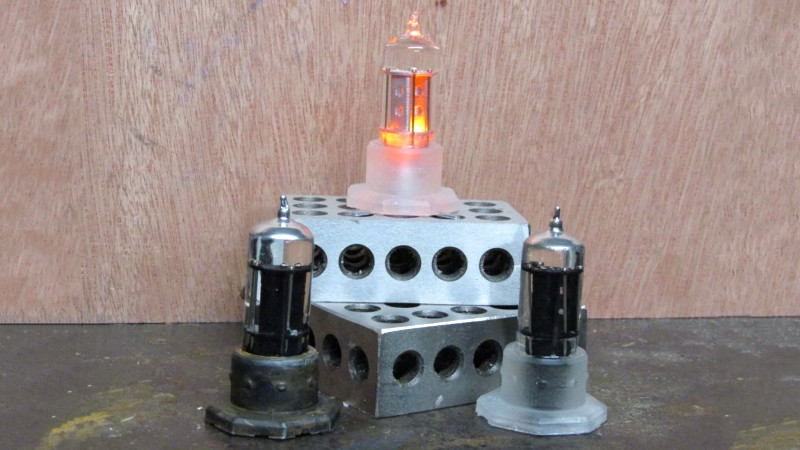Valves (tubes) certainly have a die hard fan base in the electronic community, praised for their warm sound, desirable distortion characteristics and attractive aesthetic. However, sometimes you just want the look of a valve for a prop or a toy, without actually needing the functionality. For those cases, this project from [Ajaxjones] might be just the ticket.
The build consists of taking an existing valve, combining it with a 3D printed base, and using this to create a silicone mould. 3D printed parts and dressmaker’s pins are then used to create the internal parts of the valve, and are inserted into the mould. Clear resin is then degassed, and poured into the mould to create the part. Once cured, the part is removed and the base painted to complete the look. An LED is then installed into a void in the base to give the piece a warm glow as you’d expect.
It’s a simple tutorial to producing high-quality clear plastic parts, and one that should prove useful to many prop builders and cosplayers alike. If you’re wanting to take your resin game to the next level, consider trying some overmolded parts. Video after the break.
















why is it flickering? Not a nominal tube filament action.
perhaps it already reached the end of it’s lifetime.
But despite that, it ia a really nice cast and a very informative instructable, so thanks for posting.
Lighting up wrong place, no getter (silver metal deposit on tube to maintain vacuum). The filament is in the middle surrounded by electrodes, so you shouldn’t see that much glow.
Spend $4 on aliexpress and get yourself tubes. https://www.aliexpress.com/item/32961816214.html
works out to be less than $0.8 each. Hook up 6V to the filament and watch them glow.
The first time I ever saw an antique radio with tubes plugged in and turned on those tubes had an air ingress problem causing them to fill with flickering blue plasma.
I didn’t know that they weren’t supposed to do that. I really liked how that looked. I was excited to look for a tube radio of my own. I was very disappointed when I finally got one and discovered how little there was to see.
I think these replicas are great! No, they aren’t quite 100% accurate although I’ve certainly seen worse. They aren’t meant to be functional components though. They are there for looks, in other words they are art. Have you never heard of artistic license?
Personally, if I were to do this I would probably end up using NeoPixels and have a button somewhere allowing one to toggle through various light patterns. Sure, one of the patterns would be “steady orange glow” meant to be relatively realistic but I would also have several multi-colored modes that you would likely hate.
You could always have a few voltage regulator tubes most of which maintain a glow discharge.
It’s quite pretty very subtle violet glow in the normal state and a bright glow in the you’re pushing it too hard state.
nice try, but it is not there yet. the method used is interesting though.
Amazing. This is certainly unique. Thanks for sharing.
If you wanna skip the bother and want something quick, some car headlight bulbs are pretty close looking, stick a resistor in series and figure out how many volts they need for a weak glow. Though you might wanna scrounge ones where either the main beam or regular beam have burned out, and use the other, since they’re $10 a pop usually. With one filament burnt out, they will usually have a flash of metal on the inside, which makes them look more valvey.
For extra credit, figure out how to use them as a really crappy valve. For extra extra credit, figure out how to use any burned out filament bulb as a laser valve where you slap an exciter laser diode on the side of it, to try to create an ionised bridge between electrodes. For extra extra extra credit do it with direct focused solar power. For extra extra extra extra credit, use quantum laser cooling to create 0K between the electrodes and suck out vacuum energy to power the whole project.
I would say that is a really good start!
I’m used to seeing black or brown bottom caps on the tubes I’ve seen.
I recently built my own faux vacuum tube lamp as well!
Mine is USB powered.
https://www.instagram.com/michaelmt2k/
I used a different technique in that mine is made entirely out of industrial scrap.
The body is a small oil separator and for my heater glow I used a 3mm orange LED stuck into a silicon vape cart cap as a diffusor.
I also wanted the glow of a tube on my bench at work. Glad I’m not alone!
The flickering in this one was from a LED with built in flickering effect. However due the construction and using a lost wax insert it is really easy to just swap the LED out. It beats casting the LED into the resin. Also the choice for resin instead of using old tubes is so that you don’t have the risk of broken glass. So it means it is quite good for cosplay purposes.